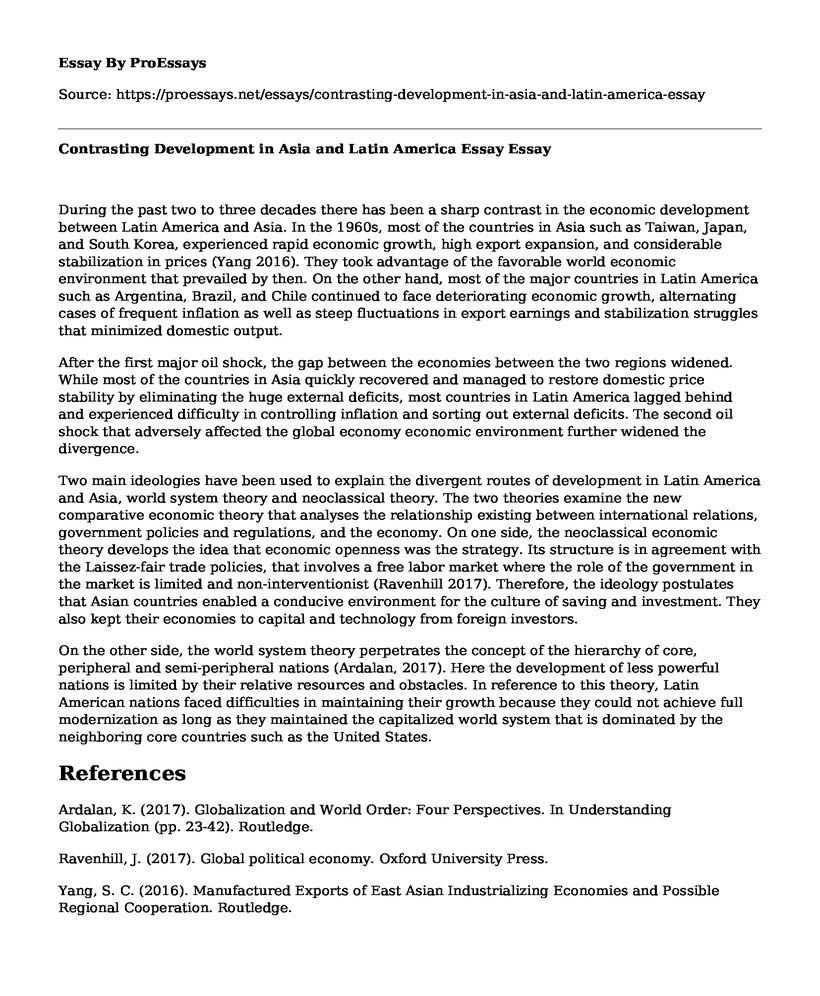During the past two to three decades there has been a sharp contrast in the economic development between Latin America and Asia. In the 1960s, most of the countries in Asia such as Taiwan, Japan, and South Korea, experienced rapid economic growth, high export expansion, and considerable stabilization in prices (Yang 2016). They took advantage of the favorable world economic environment that prevailed by then. On the other hand, most of the major countries in Latin America such as Argentina, Brazil, and Chile continued to face deteriorating economic growth, alternating cases of frequent inflation as well as steep fluctuations in export earnings and stabilization struggles that minimized domestic output.
After the first major oil shock, the gap between the economies between the two regions widened. While most of the countries in Asia quickly recovered and managed to restore domestic price stability by eliminating the huge external deficits, most countries in Latin America lagged behind and experienced difficulty in controlling inflation and sorting out external deficits. The second oil shock that adversely affected the global economy economic environment further widened the divergence.
Two main ideologies have been used to explain the divergent routes of development in Latin America and Asia, world system theory and neoclassical theory. The two theories examine the new comparative economic theory that analyses the relationship existing between international relations, government policies and regulations, and the economy. On one side, the neoclassical economic theory develops the idea that economic openness was the strategy. Its structure is in agreement with the Laissez-fair trade policies, that involves a free labor market where the role of the government in the market is limited and non-interventionist (Ravenhill 2017). Therefore, the ideology postulates that Asian countries enabled a conducive environment for the culture of saving and investment. They also kept their economies to capital and technology from foreign investors.
On the other side, the world system theory perpetrates the concept of the hierarchy of core, peripheral and semi-peripheral nations (Ardalan, 2017). Here the development of less powerful nations is limited by their relative resources and obstacles. In reference to this theory, Latin American nations faced difficulties in maintaining their growth because they could not achieve full modernization as long as they maintained the capitalized world system that is dominated by the neighboring core countries such as the United States.
References
Ardalan, K. (2017). Globalization and World Order: Four Perspectives. In Understanding Globalization (pp. 23-42). Routledge.
Ravenhill, J. (2017). Global political economy. Oxford University Press.
Yang, S. C. (2016). Manufactured Exports of East Asian Industrializing Economies and Possible Regional Cooperation. Routledge.
Cite this page
Contrasting Development in Asia and Latin America Essay. (2022, May 15). Retrieved from https://proessays.net/essays/contrasting-development-in-asia-and-latin-america-essay
If you are the original author of this essay and no longer wish to have it published on the ProEssays website, please click below to request its removal:
- Essay on Current Economic Events and How It Relates to the Principle of Macroeconomic
- Case Studies on Global Business Management
- What Is Global Perspective? Essay Example
- UAE Changes in Employment Essay Example
- Labor Relations Process Case Study
- Essay Example on Business Leaders: Making Smart Decisions for Societal Benefits
- Air Transportation - Free Report Example







